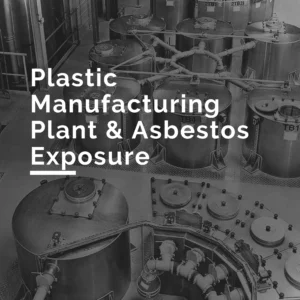Plastic manufacturing is recognized by Deskera as “the process of creating plastic products by transforming raw plastic materials into finished products.” With the rising concerns about plastic use and the increase in plastic consumption in the United States, manufacturers are being asked to create more at a quicker rate. This focus on production leaves room for error and accidents to occur, not only in the factory but in household products like “disposable diapers, trash bags, cups, utensils” as reported by the Environmental Protection Agency. Plastic manufacturing plants have been under fire by sustainability leaders but it is important to investigate the hazards for workers and the raw materials they worked closely with, more specifically asbestos.

As of 2021, the plastics industry employed roughly one million workers, which means a mass number of individuals were likely exposed to hazardous chemicals. The Occupational Safety & Health Training reported these individuals are prone to be “unaware of the potential hazards in their work environments, making them more vulnerable to injury”. The Occupational Safety and Health Administration explains some of the areas of concern in plastic manufacturing plants:
- Electrical
- Noise
- Machine Guarding
Hazard Communication is additionally a major concern to these plants. Plastic manufacturing plants are classified as a type of chemical plant because they work with hazardous raw materials to produce products. Therefore, they unfortunately struggle with the hazard communication rule described by OSHA:
“All employers with hazardous chemicals in their workplaces must have labels and safety data sheets for their exposed workers, and train them to handle the chemicals appropriately.”
While this rule is in place, Isocyanates are another concern that arises. The Centers for Disease Control and Prevention describes isocyanates as “a family of highly reactive, low molecular weight chemicals”. Under this domain, asbestos is addressed. Asbestos is a heat-resistant fiber that resembles a spindle-like shape. The National Cancer Institute explains asbestos as “a substance that causes cancer”. In the plastic manufacturing plants, asbestos was used to make the products stronger and was often used as filler. Fillers were used to “make them easier to mold and shape while ensuring the stability of the compounds” (Common Fillers and Additives in Plastic Manufacturing, 2020). Additionally, Advanced Plastiform claims the plastics that required more heat resistance often used filler to “increase heat-deflection and reduce thermal expansion”.
OSHA explains that these plastic manufacturing plants produced “asbestos-reinforced plastic molding compounds in pellet or flake form” which were shipped to other plants like “electronic, automotive, and printing”. The asbestos-contaminated plastics were used for rotators and commutators in these plants. Additionally, some of the other asbestos-contaminated plastic products produced by these plants include:
- Sleeve bearings
- Containers
- Washing machines
InspectAPedia reports some of the plastic manufacturing plants that were reported to produce plastic products containing asbestos as:
- Graylock Packing Co.
- Greene, Tweed & Co.
- Indianapolis Paint & Color Co.
- Kaiser (building products, Kaiser Gypsum plastic cement)
- Mobile Oil Co.
- National Gypsum (Gold Bond Plasticrylic, Plasticrylic Panels)
- Philip Carey (All-weather plastic cement, Plastic-asbestos cement)
- Plastics Engineering Corporation, PLENCO asbestos-containing products
Plastic Manufacturing Plants and Asbestos Exposure
After the discovery of asbestos in these plants, some filed for bankruptcy and were required to create an asbestos trust fund, which provided monetary compensation for families who had lost a family member due to asbestos-related diseases. One of the illnesses these workers could have suffered from was mesothelioma. Mesothelioma is an extremely rare type of cancer that attacks the mesothelial tissue. This tissue surrounds organs like the lungs (most common), abdomen, heart, and testicles (least common).
The cause of mesothelioma is often linked to asbestos exposure. In regard to the plastic manufacturing plants, occupational exposure would register as the cause. This means the individuals diagnosed with this condition were exposed to asbestos in these facilities. More specifically, because asbestos was used as a raw material in the molds, they were at high risk of polluting the air. This created a very hazardous place for individuals to work around as the fibers were now easily inhalable. When respirated, for long periods or short, harm has been sustained. Plastic manufacturing plants and asbestos exposure can then develop into mesothelioma.
The symptoms that often persist with mesothelioma include chest pain, persistent cough, and difficulty breathing. However, these symptoms arise following 30-40 years after exposure, marking a long latency period. While there is currently no cure for the cancer, treatments like chemotherapy and palliative care are available to minimize the severity of the symptoms.
Plastic Manufacturing Plant workers and individuals who have been exposed to and experienced symptoms of mesothelioma could be eligible for financial compensation. If you or someone you know has been affected by mesothelioma in the state of Pennsylvania, please visit The Halpern Law firm for a free consultation or call (800) 505-6000 to turn today’s adversity into tomorrow’s justice.
Sources:
https://www.oshacademy.com/pages/business-solutions/plastics_industry_safety.html
https://www.cdc.gov/niosh/topics/isocyanates/default.html
https://www.osha.gov/laws-regs/federalregister/1994-08-10
https://www.osha.gov/plastic-industry/hazards-solutions
https://www.inspectapedia.com/hazmat/Asbestos_Plastics.php
https://www.cancer.gov/about-cancer/causes-prevention/risk/substances/carcinogens
Getting the Perfect Plastic – A Closer Look at Fillers and Additives